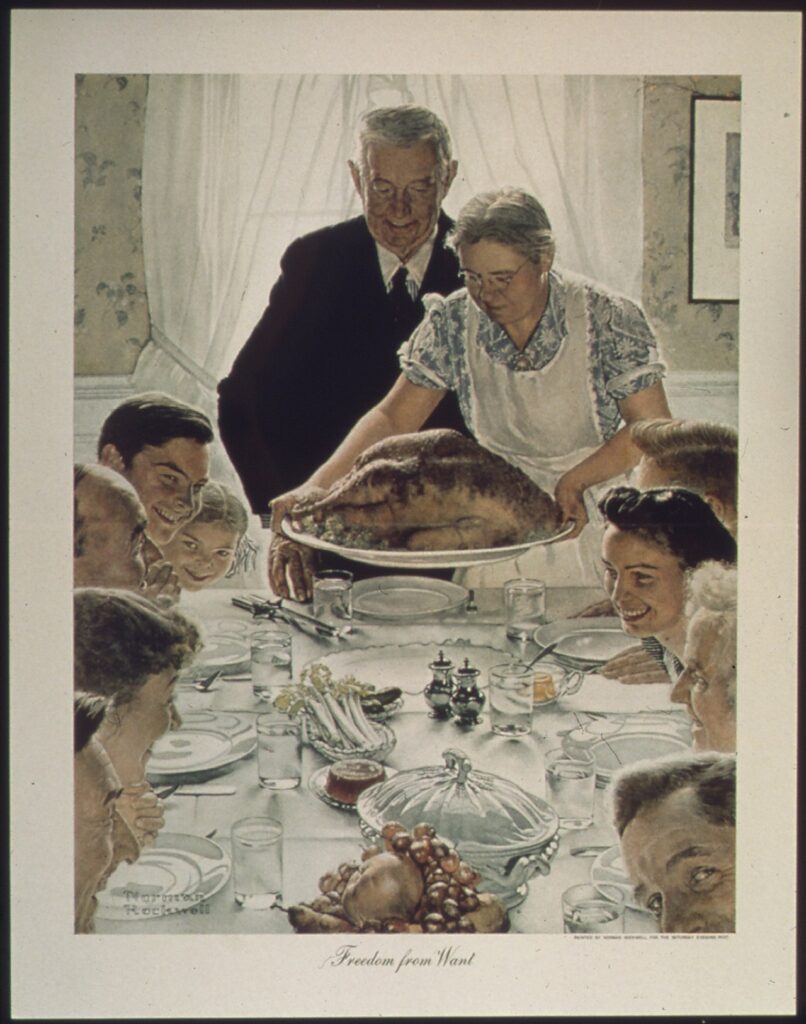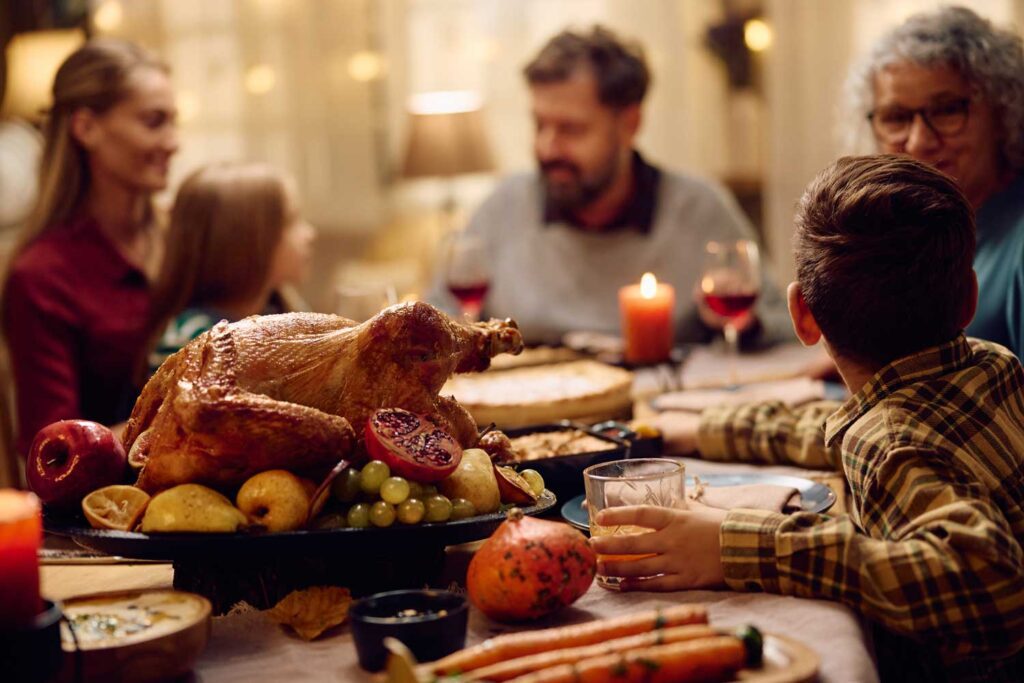No products in the cart.


There is an iconic Norman Rockwell painting that captures the essence of Thanksgiving. Subsequent artists have recreated the work, showing gatherings of diverse ethnic groups, updated fashions, and even popular fictional characters. What remains the same is the large, golden Thanksgiving turkey at the center of the design.
The upper half captures a middle-aged woman gripping the turkey platter as she sets it down to its place of honor on the table. She wears a homespun holiday dress draped with a large, pristine white apron. But her red, damp face, framed by wisps of gray hair escaping from her bun, belies the fact that she has been hard at work, probably since dawn, preparing a lavish feast. Behind her stands her husband, dressed in his best suit, poised to carve the bird.
A table decked out for the holiday and surrounded by family, young and old, stretches out below the turkey. Ironically, the guests focus on their conversation, paying no attention to the turkey. The table is set elegantly yet simply with white linen, white plates, and everyday water glasses. A decorative fruit bowl and accompaniments for the meal — salt and pepper, pickles, cranberry sauce, and celery stalks -- are arranged in the center.
Rockwell’s painting was one of four images published in The Saturday Evening Post. They illustrated President Franklin D. Roosevelt’s Four Freedoms: Freedom of Speech, Freedom of Worship, Freedom from Fear, and, lastly, Freedom from Want. Although Freedom from Want wasn’t necessarily about Thanksgiving, it captured the ideal Thanksgiving described in women’s magazines for nearly a century.
Americans haven’t always observed Thanksgiving on the fourth Thursday in November, or even annually.
Schoolchildren around the country reenact the Thanksgiving feast held at Plymouth Plantation in the fall of 1621. Billed as the “First Thanksgiving,” it’s implied Americans have been celebrating a uniquely American holiday ever since.
In reality, it took two and a half centuries for Thanksgiving to become an annual federal holiday. Before that, local leaders would randomly set aside a day for prayer and thanksgiving by proclamation. George Washington proclaimed the first National Day of Thanksgiving in 1789 during the first year of his presidency.
President Abraham Lincoln was the first to establish the fourth Thursday in November as a day of national Thanksgiving. In 1863, he called on the American people to thank God “with humble penitence for our national perverseness and disobedience [and] fervently implore … the Almighty hand to heal the wounds of the nation.…”
In 1870, Congress passed a bill establishing Thanksgiving Day as a federal holiday. Since then, Americans have enthusiastically celebrated with elaborate feasting, parades, Black Friday shopping, and back-to-back football. It would seem the one thing lost in all this is taking time to give thanks.
Humans are not easily unified. It takes the quest for survival or some crisis to bring us together. Many societal rules around etiquette and hospitality originated from the need to ensure enough resources to survive the winter and fend off invaders. At the same time, we clash over the best way to do things. And most of us are confident our view is the right one.
From the beginning of the United States, Americans have held differing views, opinions, and visions of what the nation should look like. In the 1700s, colonists had ongoing grievances against the British government. Some hoped to petition the British Parliament for relief, while others believed revolution was the only course of action. Even when war broke out, over a third of Americans were Loyalists.
The one thing they all agreed on was the “self-evident” truths listed in the Preamble of the Declaration of Independence. The American experiment was, first and foremost, one of bringing wildly diverse people together to form a new nation. One that was not formed among people of the same language, tribe, or religion but based on the concept that all humans are created equal and have “unalienable rights,” including “Life, Liberty, and the pursuit of Happiness.”
Once the United States became a political entity, American thought leaders forged their widely differing visions into a constitution and new government through debate and compromise. They aimed for workability rather than perfection because holding out for the ideal would put the states back under British governance. Humans are not easily unified. It takes the quest for survival or some type of crisis to bring us together. Many societal rules around etiquette and hospitality originated out to the need to ensure there were enough resources to make it through the winter and fend off any invaders. On the other hand, we have different opinions and perspectives, different visions of the best way to do
From the very beginnings of United States, Americans have held differing views, opinions, and visions of what the nation should look like. In the 1700s, colonists had ongoing grievances against the British government. Some hoped to petition the British Parliament for relief, while others believed revolution was the only course of action. Even when war broke out, over a third of Americans were Loyalists.
The one thing they all agreed on were the “self-evident” truths listed in the Preamble of the Declaration of Independence. The American experiment was first and foremost one of bringing a wildly diverse people together to form a new nation. One that was not formed among people of the same language, tribe, or religion, but based on the concept that all humans are created equal and have “unalienable rights,” including “Life, Liberty, and the pursuit of Happiness.”
Once the United States became a political entity, American thought leaders forged their widely differing visions into a constitution and new government through debate and compromise. They aimed for workable rather than perfection, because holding out for perfection would put them back under British governance.

It’s tempting to criticize the founding fathers for their willingness to compromise and cut deals. It’s easy to complain about all the problems in the United States today. However, complaining does little to improve anything. Psychologists have found that excessive complaining leads to a negative mindset and a sense of helplessness.
An antidote for complaining is thankfulness. Studies have shown the practice of gratitude has a profound impact, reducing stress, anxiety, and depression. A single act of gratitude temporarily produces a 10% increase in happiness and a 35% reduction in depression.
UCLA calls gratitude an essential practice for good health. Not only does it reduce negative emotions such as depression and anxiety, it contributes to stronger relationships, higher self-esteem, improved heart health, and better sleep.
No wonder American leaders have proclaimed national days of thanksgiving.
The English Separatists, or Pilgrims, landed on the Massachusetts coast in November 1620. Unlike most European colonists of the time, the Separatists were refugees escaping years of religious persecution. After anchoring in Provincetown Harbor, their first act was to sing Psalm 100, entitled A Psalm of Thanksgiving.
Almost a year later, the colonists held the “First Thanksgiving,” the one reenacted by schoolchildren. The surviving colonists celebrated their first successful corn harvest, inviting their Wampanoag neighbors to join them. The three-day festival, including feasting and games, led to a treaty and fifty years of peaceful relations.
The tale of the Thanksgiving celebration shared by Pilgrims and Native Americans is woven into our unique national identity. Sarah Josepha Hale, Mother of Thanksgiving, helped transform a historical footnote into an American legend. Hale edited Godey’s Lady’s Book and Magazine, played a crucial role in founding Vassar College, and authored “Mary Had a Little Lamb.”
For fifty years (1827-1877), she published columns and articles that promoted her vision for a National Day of Thanksgiving. Her magazine was filled with articles detaining the carefully crafted Thanksgiving traditions we know and love. For her, Thanksgiving had the power to unify Americans from diverse backgrounds living in a rapidly expanding nation sprawled over an entire continent. Hale taught American women a “standardized celebration” to be observed by all Americans.
She also argued the case for a national Thanksgiving in letters to every president from Polk (1846) to Lincoln (1863). And Lincoln, struggling to hold together a nation torn apart by civil war, decided to heed her. Five days after receiving her letter, Lincoln issued the proclamation establishing the fourth Thursday in November as a National Day of Thanksgiving.
Since Lincoln’s proclamation, Thanksgiving took root in the United States as a patriotic celebration. However, make sure your celebration isn’t just about food and football. Take the time to express thankfulness for all the blessings we enjoy, even when life isn’t perfect. Keep the spirit of Thanksgiving alive by cultivating the habit of gratitude. Many people find it helpful to keep a gratitude journal to record at least three things they are thankful for every day.
Don’t forget that Thanksgiving is an official flag holiday. It’s the perfect day to fly your Stars and Stripes. Display it outside your home or business from sunrise to sunset. Or use an indoor variety as part of your festive decorations.
With winter’s harsh weather blowing in, you might consider using one of our sturdy polyester flags. These beauties are designed to withstand windy conditions and other inclement weather. Check out our selection of 100% American-made polyester flags for all your winter needs.